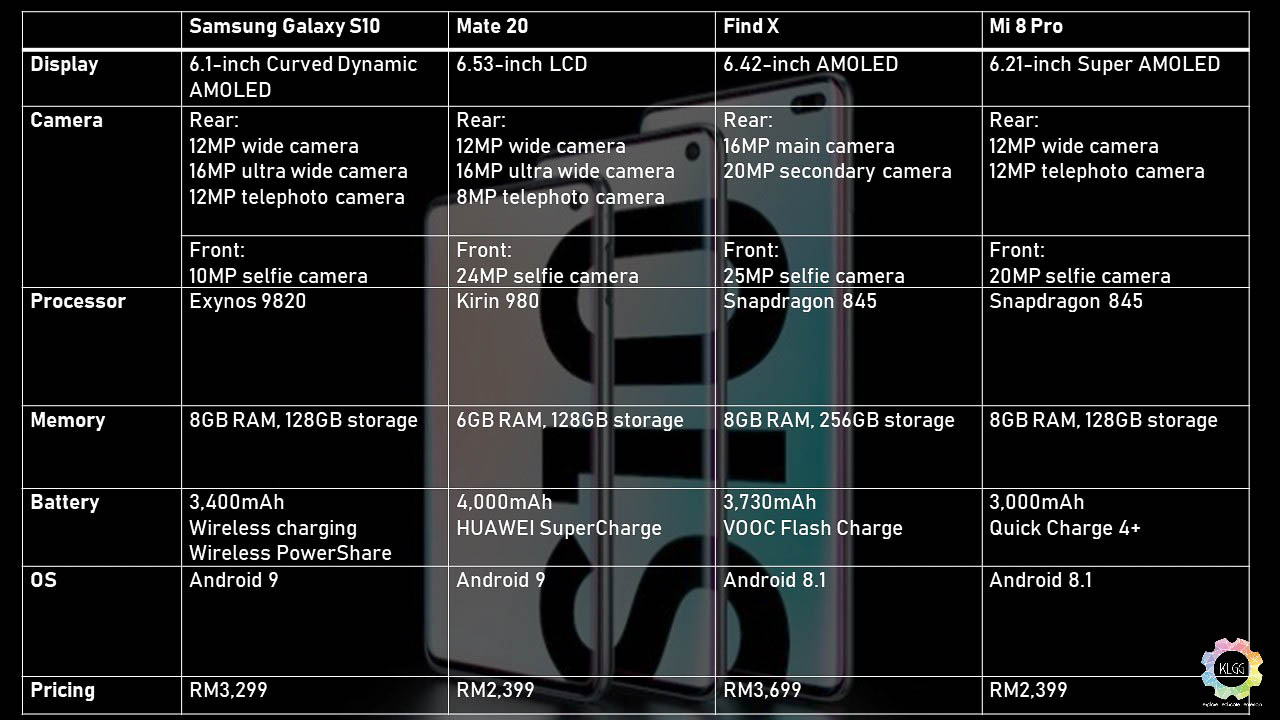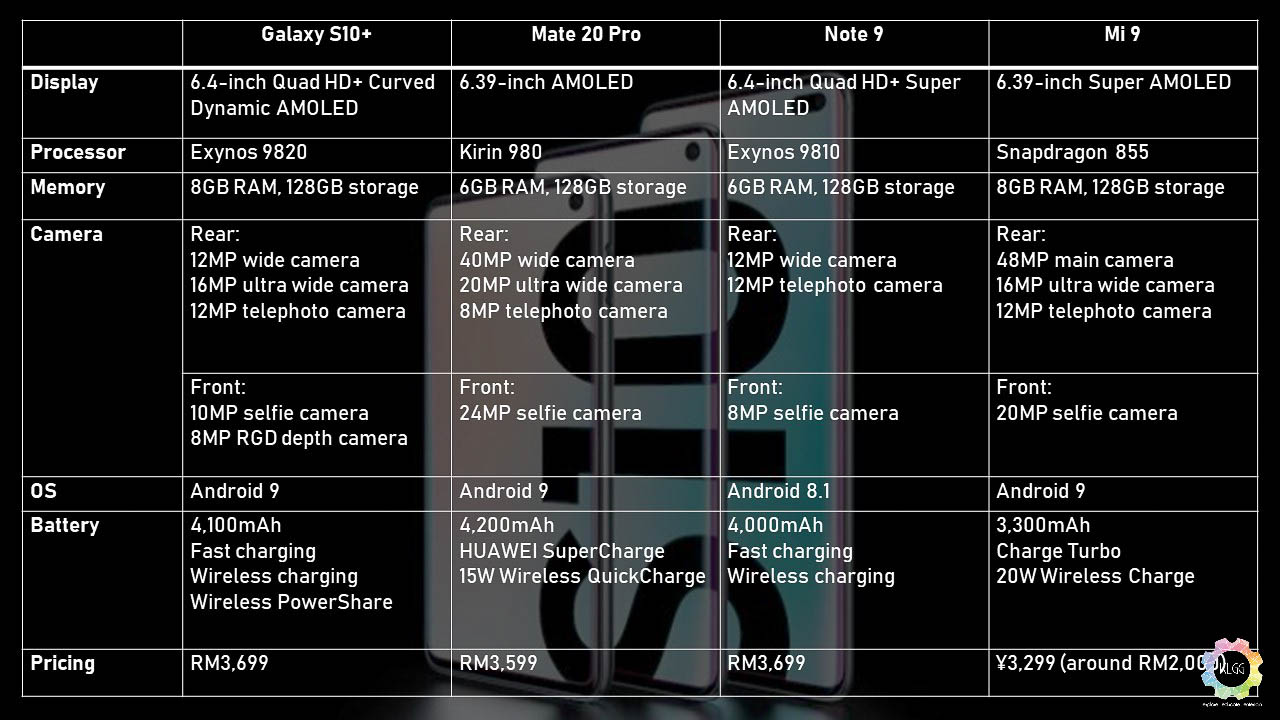Now that the Samsung Galaxy S10 lineup is launched, you’ve probably been wondering how the S10 lineup holds up against its competitors. Our specs shootout guide should help you along your way to making your next smartphone purchase.


The S10e will be the most affordable variant of the S10 series of smartphones – it’s marketed as the more accessible model with a smaller display and lower spec components. Here, we’ll be comparing the S10e to other low-end variants of flagship phones – the Apple iPhone XR, Huawei P20; and the Mi 9 SE.
Beginning with the S10e, you get a compact 5.8-inch Flat Dynamic AMOLED display, which is the smallest screen of the lot. The Apple iPhone XR sports a 6.1-inch display, the P20 gets a 5.84-inch screen while the Mi 9 SE a display of 5.97-inch. It’s worth mentioning that the iPhone and P20 utilize IPS LCD displays. Meanwhile the S10e Dynamic AMOLED display is supposedly able to produce improved contrast accuracy. Moving on to the camera, Samsung’s dual camera setup comes with a 12MP+16MP wide and ultrawide combination. Although the P20 also sport two main lenses, they are standard and while the iPhone only comes with one main camera, its naturally-saturated image quality is a plus point. However, the Mi 9 SE shines in this aspect because it comes with a powerful 48MP main camera combined with a 13MP ultra wide camera and also an 8MP telephoto camera.
The S10e, despite being the low-end variant, comes with the Exynos 9820, one better than Huawei’s Kirin 659 and the Mi 9 SE’s Snapdragon 845. However, Apple’s A12 Bionic chipset is arguably a tad bit more powerful than the Snapdragon 855. The S10e’s 3,100mAh battery is expected for a low-end flagship. While the P20 has a bigger battery size, it does not support wireless charging and also reverse wireless charging like the S10e’s Wireless PowerShare.
For below RM3,000, the Galaxy S10e’s is a steal considering it sports top-of-the-line specs. Its newer components compared and software make it a good choice if you’re looking for a new daily driver.


Moving on to the Galaxy S10, the first thing you’ll notice is that it has a smaller display compared to the rest, but it has an AMOLED panel like the Mi 8 Pro and the Find X so it does have better colour contrast than the Mate 20. The S10 also has an extra third lens that the Find X and Mi 8 Pro doesn’t, and its 12MP telephoto lens is better than the Mate 20’s 8MP telephoto lens. However, the other phones perform better when it comes to selfies because the S10 only has a 10MP front camera.
In terms of processor, all four phones have top-notch processors though the Exynos 9820 is said to perform better when compared to the Snapdragon 845. The S10 is similar with the Mi 8 Pro when it comes to RAM and storage, while the Find X has a higher storage and the Mate 20 has a lower RAM. The Galaxy S10 and Mate 20 also comes with Android 9 while the other two comes with Android 8.1, but what really matters is the battery life of these phones. The S10 ranks the third when it comes to battery size, but it does support wireless charging and also Wireless PowerShare which the rest doesn’t.
What matters most is the pricing of each phone. The OPPO Find X is pricier than the S10, but it does have a higher storage and battery capacity. However, it only comes with dual rear camera and does not support wireless charging and reverse wireless charging. On the other hand, the cheaper Mi 8 Pro lacks an extra camera, a bigger battery and also support for wireless and reverse charging. To be honest, the Mate 20 should be the closest competitor to the S10. The Mate 20 has bigger display, better front camera and higher battery size but the S10 has bigger RAM, more charging features and a slightly better telephoto camera. It all goes down to whether you’d want to spend an extra RM900 for these features.


Now, on to the biggest and beefiest of the lot, the S10+. It’s got all the bells and whistles, and then some. Here, we’ll be pitting it against the Huawei Mate 20 Pro, Note 9 and the Mi 9, mainly due to their similar sizes and prices.
It sports a whopping 6.4-inch Quad HD+ Curved Dynamic AMOLED Display, while its competitors also sport similarly sized AMOLED screens. The S10+ wins here with the newer Curved Dynamic tech. Moving on to the camera, the Mi 9 takes the cake with its triple-lens 48MP main camera setup. Galaxy S10+ comes with a triple-lens setup too but with a 12MP wide + 16MP ultrawide + 12MP telephoto combination. So definitely go for the Mi 9 if you want sharper photos.
Meanwhile, The Mate 20 Pro wins in the front-facing camera department with a 24MP lens; but the Samsung is unique in that it sports two lenses – one 10MP lens that’s paired with an 8MP RGD depth camera.
Powering the Samsung is an Exynos 9820 which is on par, if not slightly better than Huawei’s Kirin 980. It needs to be said however, that the Exynos 9820 is based on the 8nm process while the Kirin 980 and Mi 9’s Snapdragon 855 one-ups Exynos with the 7nm process. Note 9’s older generation Exynos 9810 falls behind the other more current-gen chipsets. In terms of battery, the S10+ gets a respectable 4,100mAh battery while the Mate 20 Pro gets a slightly larger 4,200mAh battery. All phones come with their own version of fast charging, but the S10+ gets wireless charging and wireless reverse charging.
The Galaxy S10+ is slapped with an expect RM3,699 price tag, only RM100 more than older Mate 20 Pro. But if you want affordable, The Mi 9 should be your pick, costing only RM2,000.


